I had a great chat with a thruuu user. He came across a common dilemma that confuses many of us in the SEO game: When you’ve got a bunch of closely related keywords, how many articles do you actually need to write?
Here’s what happened.
The user explored the result of the thruuu’s keyword clustering tool, and it highlighted two article ideas. One is about “zero-emission vehicle definition” and the other is about “California air resources board zero-emission vehicle.”
As he is an expert in this field, for him, these two topics seemed so close that they should be covered in one single article, and here is what he asked me:
“Even though the SERPs differ and the queries aren’t identical, I find it hard to talk about zero-emission vehicles without bringing up the California Air Resources Board. After all, they’re the ones who coined the term ‘zero-emission vehicle.‘”
This dilemma started an engaging discussion about making the most of keyword clustering and avoiding content overlaps.
Let’s figure out together if he should write one or two articles.
Table of Contents
Identifying user intent
One practical way to determine whether to write one or two articles for a set of keywords is to examine the user intent behind each keyword.
For instance, the keywords “Apple iPhone 13 features” and “How to use iPhone 13 camera” may appear closely related but serve different user intents.
The first keyword likely targets those considering buying the iPhone 13 and wanting to understand its features. In contrast, the second keyword targets current iPhone 13 users looking to maximize their use of the device’s camera.
Recognizing these different intents can guide you to create two distinct articles that adequately answer each audience’s needs.
It is exactly the goal of the keyword clustering tool within thruuu.
Starting from a large set of keywords, it will group keywords displaying the same SERP. These grouped keywords answer the same intent.
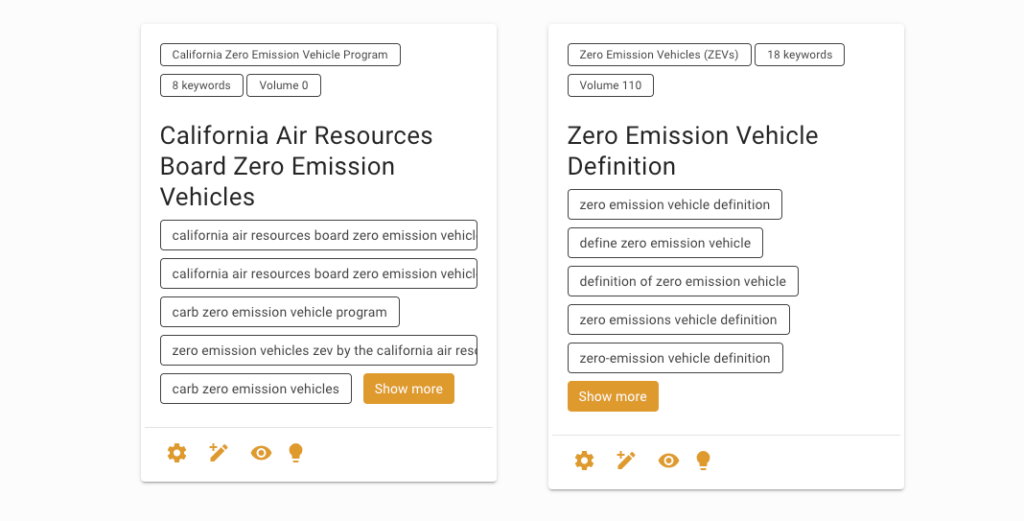
When you look closer at the top content ranking for the search “zero-emission vehicle definition” and “California air resources board zero-emission vehicle” you can see different content and decipher different intent.
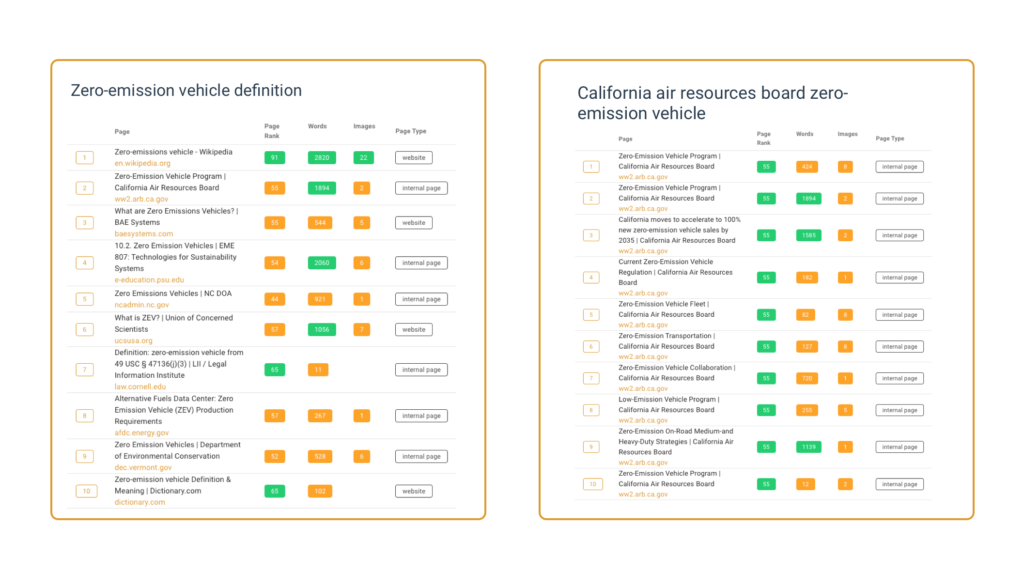
Note: With thruuu’s keyword clustering tool, you get an aggregated view of a set of SERPs per cluster. It helps you quickly identify the main content ranking for a content cluster.
Let’s break the search intent down.
If someone searches for ‘zero-emission vehicle definition‘, he wants to know what it is. He might even don’t know what the California Air Resources Board is.
As you can see below, there are several websites (in red), including Wikipedia offering a definition of zero-emission vehicle. There is also a link to the website (in green) about the California air resources board as it is an authoritative source on the topic.
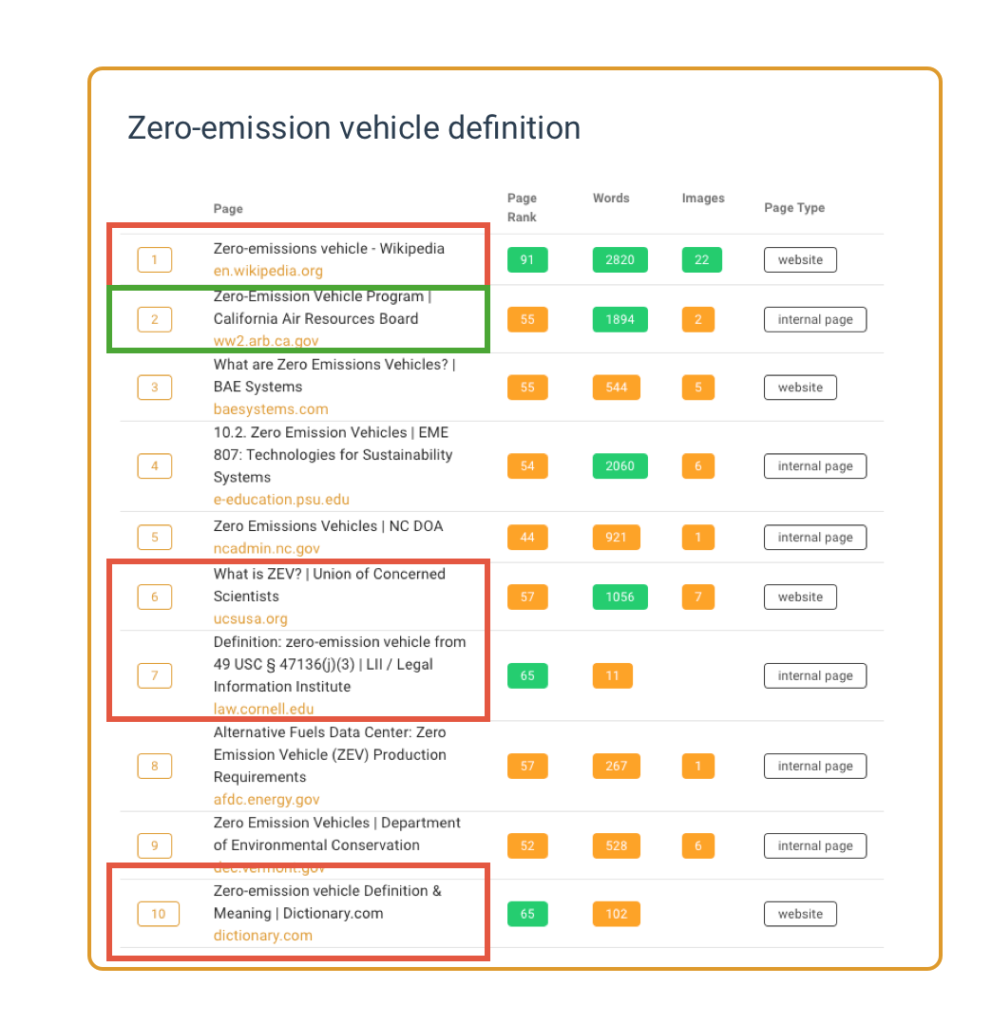
On the other hand, if someone types in ‘California air resources board zero emission vehicle‘, they’re likely interested in the specifics of this program – its rules or the vehicles it allows.
We could even consider this request as navigational as the California Air Resources Board website owns the first page of Google.
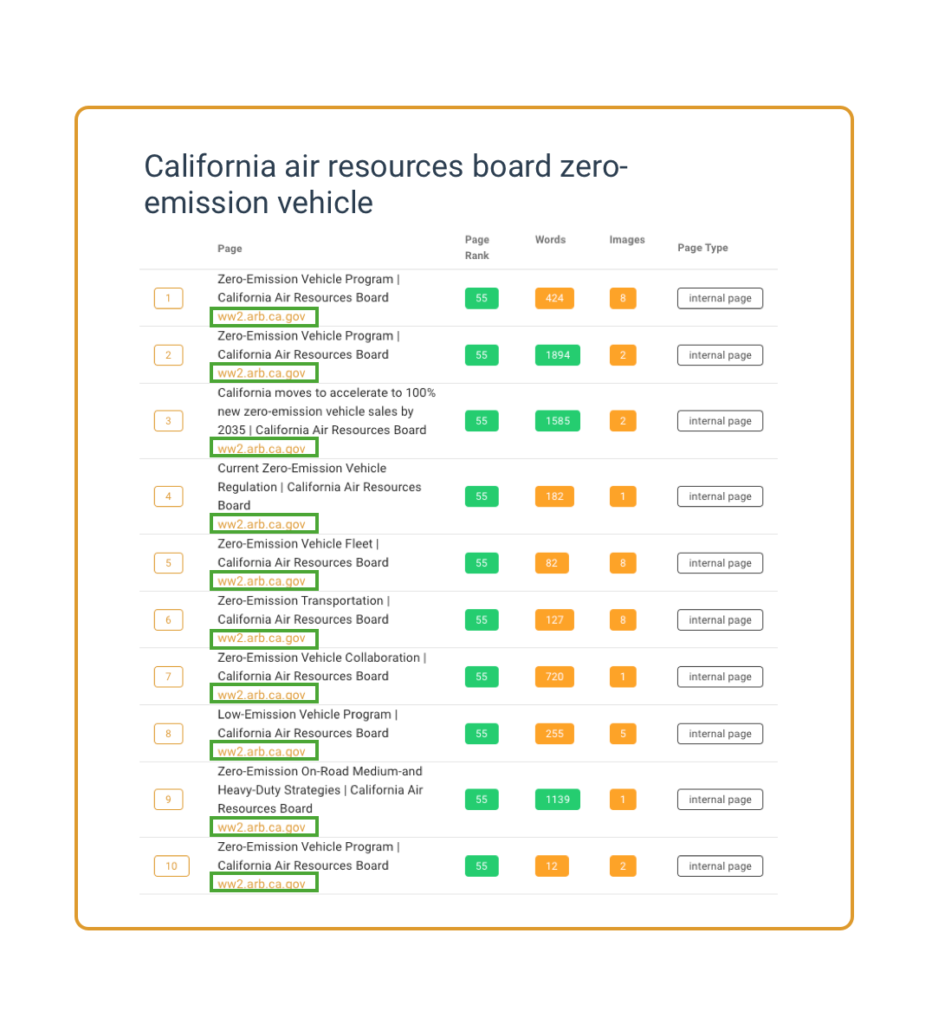
If we look at the details of the cluster about “California air resources board zero-emission vehicle“, we can clearly see that there is no space for competitors.
For the 8 keywords in the cluster, the arb.ca.gov website rank on every SERPs and at several positions as indicated by the Page 1 Visibility metric.

Our conversation continued, and the user said, “In a scenario like this, I’ve written one article, but not two, and I’ve managed to answer both queries in a single piece. Is this the right approach, do you think?“
Sure, we could create one single article.
But also we could create two articles focused on each keyword.
Content structuring: Focus on one keyword per article
I suggested two content outlines to prove that you could create two articles.
The “Zero-Emission Vehicle Definition” article might start with a broad introduction and gradually delve into zero-emission vehicles’ types, advantages, and challenges.
Conversely, the “California Air Resources Board’s Zero Emission Vehicle” article might focus more on program regulations, collaborative efforts, and future outlook.
Indeed it could offer something different from what is already on the SERP and give an overview of the California Air Resources Board.
The following article structures were generated automatically by the content brief generator of thruuu.

However, from his perspective, these two outlines share too many topics in common. He replied: “I’ve just had a closer look at the two proposed outlines and see that there are a lot of sections that cover the same thing, like zero-emission vehicles, for example – is this not duplicate content in Google’s eyes?“
Fair point.
Distinguishing between content overlap and content duplication
A key consideration in this discussion is the difference between overlapping and duplicating content.
Overlapping content occurs when different articles contain sections sharing the same topic, yet each article answers a distinct user intent. Duplicate content, on the other hand, simply reproduces the same information with slight variations.
For example, an SEO blog may have two overlapping articles, each explaining a concept like “Backlinks in SEO”.
One article might help beginners understand the basics, while the other targets advanced users seeking optimization techniques.
Although they share common sections, their unique approaches serve distinct user intents.
The user shared an interesting comment: “On the one hand, it seems natural and logical to include those things in both articles, but on the other, it seems like I’m publishing the same thing with different words“.
Including “same things” in several articles might happen many times as soon as your blog grows. Then you get great opportunities to link your articles and connect concepts.
For instance, the article “Zero-Emission Vehicle Definition” might introduce regulations and discusses the California Air Resources Board Program.
A good approach will be creating a small paragraph explaining the program and providing a link to the page detailing the program.
On the other side, the article about the program might speak about Zero-Emission vehicles. Here insert a link to the definition.
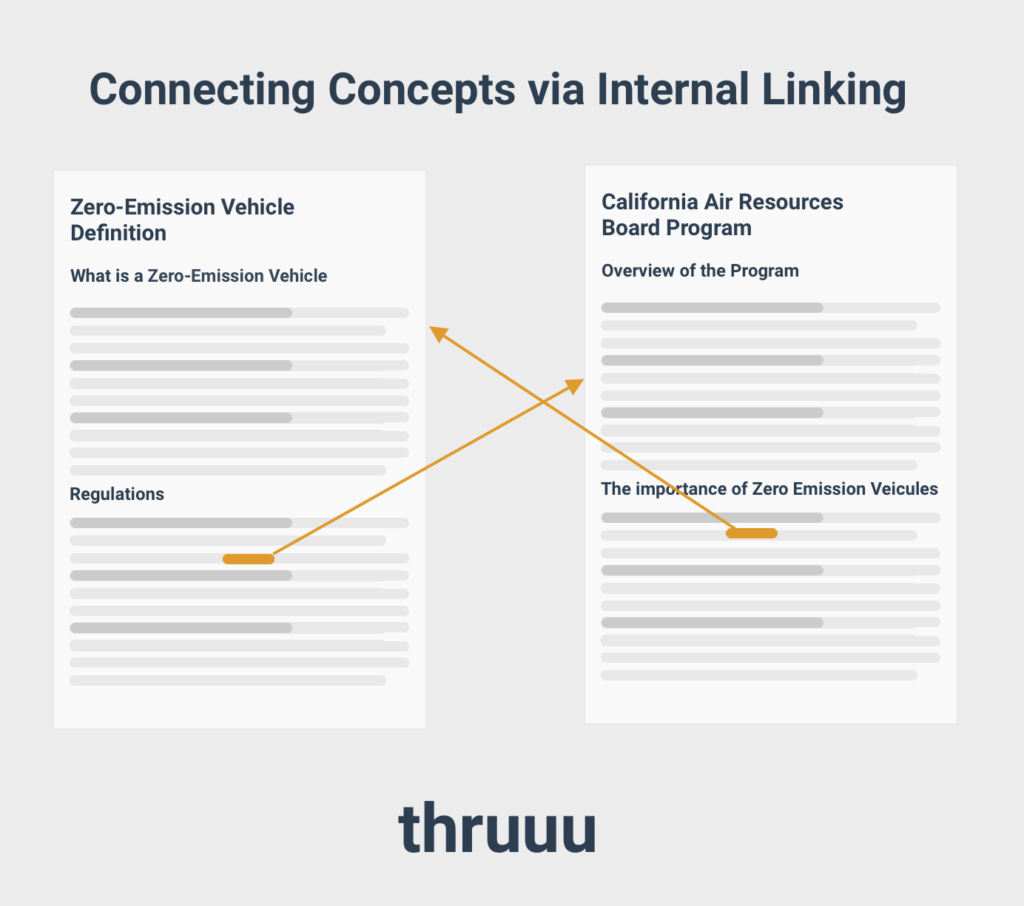
Navigating keyword clustering
He also highlighted that he found several spokes or clusters that seem closely related within a hub.
Below you see the content hub view of thruuu keyword clustering.

The keyword clustering process might output some clusters with closely related topics, especially when you upload a huge set of keywords.
Remember that each cluster group keywords show the same SERPs( or SERPs with at least 4+ URLs in common). Theoretically, you could create a dedicated article per cluster.
But it might be hard to find a unique article for each in some cases.
Please don’t feel overwhelmed or confused, and follow my recommendation.
My recommendation is to be pragmatic.
- Select the most important clusters.
- Hide the ones that make less sense
- Reorganize the clusters in the right category (or create new categories)
- Build your hub of content with selected articles.
thruuu allows you to visualize your clusters within dedicated hubs and reorganize them. Learn more about this here.
Finally, you don’t need to create one article per cluster. Start with creating a few of them, track the performance of your content, and then add additional content to your hub.
Be pragmatic and track your SEO performance
Another pragmatic approach to validate your content strategy is to track your keyword rankings after publishing.
If you decide to cover two related topics in a single article and later find that you’re ranking in the top 3 for both keywords, your decision was probably effective.
However, if your article only ranks well for one keyword, it may indicate the need for a separate piece to better cater to the second keyword.
The “Page” report of the thruuu keyword clustering tool gives you great insights into your content strategy. The report shows for how many clusters a page ranks in the top 10.
In other words, it shows the topical depth of an article.
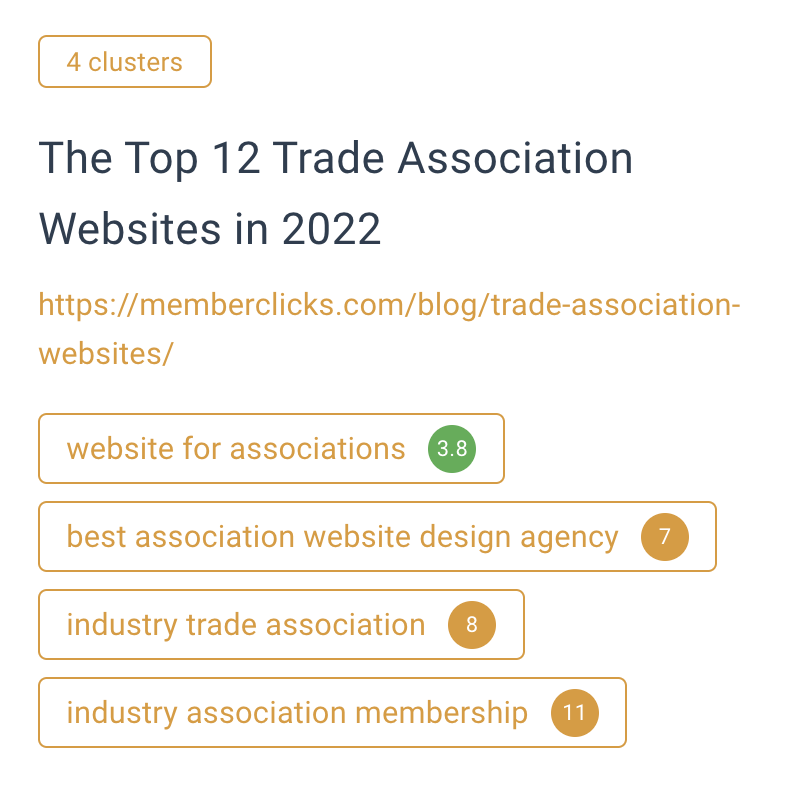
As a cluster represents a topic or a specific intent, an article ranking for several clusters means it answers to several intents.
This can be good if your article ranks in the top 3, but if not, you might want to create several articles for each specific topic to increase your performance.
Watch the following video for more details about how to leverage the Page report.
Exploring diverse aspects of a topic
As we concluded our discussion, we agreed that SEO isn’t just about avoiding overlapping content. It’s also about providing a wide range of valuable content that enriches the user’s experience.
Even closely related articles can provide diverse insights or delve into different aspects of the topic, offering users a more comprehensive understanding.
Remember, SEO isn’t just about sidestepping content overlap or duplication; it’s also about enriching your site with varied and valuable content.
For instance, if you’re writing about a broad topic like “Digital Marketing”, it might be beneficial to create separate articles covering subtopics such as “Social Media Marketing”, “Content Marketing”, and “Email Marketing”.
Each piece will provide a unique angle, appealing to different user intents and enriching the overall user experience.
To sum up, navigating the SEO landscape is an exercise in strategic planning, understanding user intent, and regularly monitoring site performance.
It may seem daunting initially, but with each challenge comes an opportunity to learn and enhance your SEO skillset.
Ultimately, the goal is to create content that serves a unique purpose, addresses specific user intents, and offers value to your audience.
Get Started and Cluster 500 Keywords for Free
Organize your content for improved SEO and user experience with our Keyword Clustering and Topic Clusters feature.
